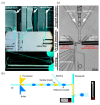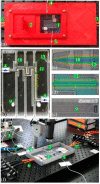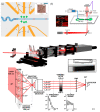On-Chip Photonic Detection Techniques for Non-Invasive In Situ Characterizations at the Microfluidic Scale
- PMID: 38475065
- PMCID: PMC10933925
- DOI: 10.3390/s24051529
On-Chip Photonic Detection Techniques for Non-Invasive In Situ Characterizations at the Microfluidic Scale
Abstract
Microfluidics has emerged as a robust technology for diverse applications, ranging from bio-medical diagnostics to chemical analysis. Among the different characterization techniques that can be used to analyze samples at the microfluidic scale, the coupling of photonic detection techniques and on-chip configurations is particularly advantageous due to its non-invasive nature, which permits sensitive, real-time, high throughput, and rapid analyses, taking advantage of the microfluidic special environments and reduced sample volumes. Putting a special emphasis on integrated detection schemes, this review article explores the most relevant advances in the on-chip implementation of UV-vis, near-infrared, terahertz, and X-ray-based techniques for different characterizations, ranging from punctual spectroscopic or scattering-based measurements to different types of mapping/imaging. The principles of the techniques and their interest are discussed through their application to different systems.
Keywords: analytical chemistry; lab-on-a-chip; microfluidics; photonic detection; sensors; spectrometry.
Conflict of interest statement
The authors declare no conflicts of interest.
Figures













Similar articles
-
Integrated Photonic Biosensors: Enabling Next-Generation Lab-on-a-Chip Platforms.Nanomaterials (Basel). 2025 May 13;15(10):731. doi: 10.3390/nano15100731. Nanomaterials (Basel). 2025. PMID: 40423121 Free PMC article. Review.
-
Prospects of Microfluidic Technology in Nucleic Acid Detection Approaches.Biosensors (Basel). 2023 May 27;13(6):584. doi: 10.3390/bios13060584. Biosensors (Basel). 2023. PMID: 37366949 Free PMC article. Review.
-
Microfluidics-to-mass spectrometry: a review of coupling methods and applications.J Chromatogr A. 2015 Feb 20;1382:98-116. doi: 10.1016/j.chroma.2014.10.039. Epub 2014 Oct 23. J Chromatogr A. 2015. PMID: 25458901 Free PMC article. Review.
-
Photonic crystal biosensors towards on-chip integration.J Biophotonics. 2012 Aug;5(8-9):601-16. doi: 10.1002/jbio.201200039. Epub 2012 Jun 8. J Biophotonics. 2012. PMID: 22678992 Review.
-
Microfluidics Integrated Biosensors: A Leading Technology towards Lab-on-a-Chip and Sensing Applications.Sensors (Basel). 2015 Dec 1;15(12):30011-31. doi: 10.3390/s151229783. Sensors (Basel). 2015. PMID: 26633409 Free PMC article. Review.
Cited by
-
Biophotonic (nano)structures: from fundamentals to emerging applications.RSC Adv. 2025 Jul 22;15(32):26138-26172. doi: 10.1039/d5ra03288a. eCollection 2025 Jul 21. RSC Adv. 2025. PMID: 40697453 Free PMC article. Review.
-
Integrated Photonic Biosensors: Enabling Next-Generation Lab-on-a-Chip Platforms.Nanomaterials (Basel). 2025 May 13;15(10):731. doi: 10.3390/nano15100731. Nanomaterials (Basel). 2025. PMID: 40423121 Free PMC article. Review.
References
-
- Manz A., Graber N., Widmer H.M. Miniaturized Total Chemical Analysis Systems: A Novel Concept for Chemical Sensing. Sens. Actuators B Chem. 1990;1:244–248. doi: 10.1016/0925-4005(90)80209-I. - DOI
-
- Gravesen P., Branebjerg J., Jensen O.S. Microfluidics—A Review. J. Micromech. Microeng. 1993;3:168. doi: 10.1088/0960-1317/3/4/002. - DOI
Publication types
Grants and funding
LinkOut - more resources
Full Text Sources
Miscellaneous

